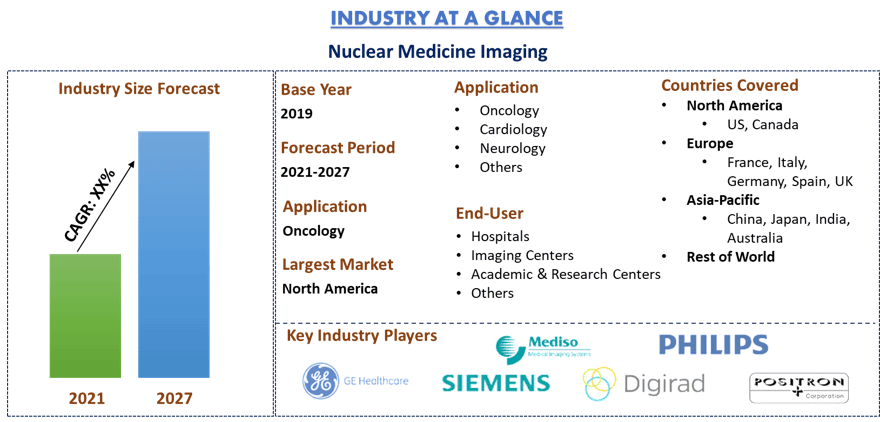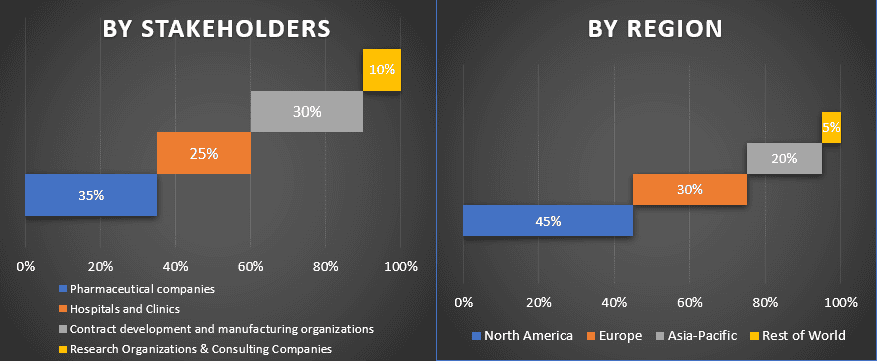- Home
- About Us
- Industry
- Services
- Reading
- Contact Us
Nuclear Medicine Imaging Market: Current Analysis and Forecast (2021-2027)
Emphasis on Product Type (SPECT Imaging Systems, PET Imaging Systems, Planar Scintigraphy Imaging System); Application (Oncology, Cardiology, Neurology, Others); End-User (Hospitals, Imaging Centers, Academic & Research Centers, Others) and Region & Country.
Nuclear Medicine Imaging Market was valued at ~US$ 3.5 billion in 2020 and is expected to grow at a CAGR of ~5% over the forecast period (2021-2027). Instead of physical forms and shapes, nuclear medicine imaging takes photos based on the chemistry of the human body. Due to the rising prevalence of target illnesses, the technology is seeing a spike in usage. The increase in incidences of diseases such as cancer, neurological diseases, and cardiovascular diseases globally owing to the increase in geriatric population has been one of the prime factors that augment market growth. In 2020, according to WHO, cancer was considered among the leading cause of death in the world. Nearly 10 million people die due to cancer each year, making it the second leading cause of death across the world. Nuclear medicine scans can help in finding tumors and analyzing how much cancer has spread in the body (called cancer’s stage). They can also be used to determine whether treatment is effective. Furthermore, one of the key drivers for the market is the growth in the occurrence of cancer and cardiac diseases. The incidence of cardiovascular diseases has been increasing worldwide. For instance, as per the Adult Trusted source, in 2018, 30.3 million people in the United States were diagnosed with heart disease. Heart disease is the leading cause of death in the United States, with around 647,000 deaths per year. One out of every four deaths is due to heart disease. Nuclear medicine has a lot of potential for treating cancer and heart disease. Moreover, there is substantial evidence that using nuclear imaging techniques to diagnose a tumor has a greater influence on patient management in terms of tumor surveillance and treatment response.
In the last decade, there has been a major evolution of hybrid systems due to technological breakthroughs in the field of imaging. The use of integrated PET modalities is a significant advancement in this area. The PET/CT modality has been so successful in terms of innovation that major imaging system manufacturers no longer offer solo PET systems. Furthermore, one of the key drivers for the market is the growth in the occurrence of cancer and cardiac diseases. Nuclear medicine has a lot of potential for treating cancer and heart disease. There is substantial evidence that using nuclear imaging techniques to diagnose a tumor has a greater influence on patient management in terms of tumor surveillance and treatment response.
The rise in venture capital investments coupled with the technological advancement in medical technology due to the worldwide demand for therapeutic alternatives to surgeries is augmenting the growth of the Nuclear Medicine Imaging market. For instance, in 2020, the value of these investments totaled out to be around 6.3 billion U.S. dollars. Apart from this, there was the largest increase in the value of MedTech venture capital investments between 2016-2017. Moreover, medical imaging and nuclear medicine play a critical role in tackling epidemiologic objectives ranging from infectious diseases like tuberculosis to non-communicable diseases (such as cancer and heart disease) and more. There are still significant access gaps.
Siemens Healthineers, GE Healthcare, Philips, Digirad Corporation, Mediso Medical Imaging Systems, Positron Corporation, Cardinal Health Inc., Bracco Imaging SpA, Hitachi Medical Corporation, and Canon Medical Systems Corporation are some of the prominent players operating in the global Nuclear Medicine Imaging market. Several M&A’s along with partnerships have been undertaken by these players to facilitate customers with hi-tech and innovative products.
Insights Presented in the Report
“Amongst Product Type, SPECT Imaging Systems segment holds the major share”
Based on product, the market is fragmented into SPECT Imaging Systems, PET Imaging Systems, and Planar Scintigraphy Imaging System. The SPECT Imaging Systems segment dominated the market with a share of XX% in 2020 and is expected to maintain its dominance during the forecast period owing to the technological advancement and rising adoption of these devices across various industries.
“Amongst Application, Oncology is anticipated to grow at the highest CAGR during the analyzed period”
Further based on the application, the market is fragmented into oncology, cardiology, neurology, and others. In 2020, oncology accounted for a maximum market revenue share of XX% and is expected to remain dominant during the analyzed period. However, the cardiology segment is anticipated to grow at the highest CAGR over the forecast period and reach a market evaluation of USD XX million. For instance, as per the Adult Trusted source, in 2018, 30.3 million people in the United States were diagnosed with heart disease.
Amongst End-User, the hospital’s segment holds the major share”
Based on the end-user type, the market is fragmented into hospitals, imaging centers, academic & research centers, and others. The hospitals dominated the market in 2020 with revenue of USD XX million and is anticipated to maintain their dominance during the analyzed period. Furthermore, the segment is also expected to grow at the highest CAGR during the period.
“North America signifies one of the largest markets of Nuclear Medicine Imaging Market”
For a better understanding of the market dynamics of the Nuclear Medicine Imaging market, a detailed analysis was conducted for different regions across the globe including North America (United States, Canada, and the Rest of North America), Europe (Germany, France, Italy, Spain, United Kingdom and Rest of Europe), Asia-Pacific (China, Japan, India, and Rest of APAC), and Rest of World. North America dominated the market and generated revenue of USD XX million in 2020 owing to the increased number of cancer and heart disease cases. In America, nearly 1.9 million new cancer cases are expected to be diagnosed in 2021. Approximately 608,570 Americans are expected to die of cancer in 2021, which translates to about 1,670 deaths per day. Cancer is the second most common cause of death in the US, exceeded only by heart disease.
Reasons to buy this report:
- The study includes market sizing and forecasting analysis validated by authenticated key industry experts
- The report presents a quick review of overall industry performance at one glance
- The report covers an in-depth analysis of prominent industry peers with a primary focus on key business financials, product portfolio, expansion strategies, and recent developments
- Detailed examination of drivers, restraints, key trends, and opportunities prevailing in the industry
- The study comprehensively covers the market across different segments
- Deep dive regional level analysis of the industry
Customization Options:
Nuclear Medicine Imaging Market can further be customized as per the requirement or any other market segment. Besides this, UMI understands that you may have your own business needs, hence feel free to connect with us to get a report that completely suits your requirements.
Table of Content
Analyzing the historical market, estimation of the current market, and forecasting the future market of the Global Nuclear Medicine Imaging Market were the three major steps undertaken to create and analyze the adoption of Nuclear Medicine Imaging for the different diseases across major regions globally. Exhaustive secondary research was conducted to collect the historical market numbers and estimate the current market size. Secondly, to validate these insights, numerous findings and assumptions were taken into consideration. Moreover, exhaustive primary interviews were also conducted, with industry experts across the value chain of the Nuclear Medicine Imaging sector. Post assumption and validation of market numbers through primary interviews, we employed a top-down/bottom-up approach to forecast the complete market size. Thereafter, market breakdown and data triangulation methods were adopted to estimate and analyze the market size of segments and sub-segments the industry pertains to. Detailed methodology is explained below:
Analysis of Historical Market Size
Step 1: In-Depth Study of Secondary Sources:
Detailed secondary study was conducted to obtain the historical market size of the Nuclear Medicine Imaging through company internal sources such as annual report & financial statements, performance presentations, press releases, etc., and external sources including journals, news & articles, government publications, competitor publications, sector reports, third-party database, and other credible publications.
Step 2: Market Segmentation:
After obtaining the historical market size of the Nuclear Medicine Imaging market, we conducted a detailed secondary analysis to gather historical market insights and share for different segments for major regions. Major segments included in the report are therapy, application, and end-user. Further country-level analyses were conducted to evaluate the overall adoption of Nuclear Medicine Imaging in every region.
Step 3: Factor Analysis:
After acquiring the historical market size of different segments and sub-segments, we conducted a detailed factor analysis to estimate the current market size of Nuclear Medicine Imaging. Further, we conducted factor analysis using dependent and independent variables such as increasing cancer incidence and the growing geriatric population. A thorough analysis was conducted for demand and supply-side scenarios considering top partnerships, merger and acquisition, business expansion, and product launches in the Nuclear Medicine Imaging industry across the globe.
Current Market Size Estimate & Forecast
Current Market Sizing: Based on actionable insights from the above 3 steps, we arrived at the current market size, key players in the Nuclear Medicine Imaging market, and market shares of the segments. All the required percentage shares split, and market breakdowns were determined using the above-mentioned secondary approach and were verified through primary interviews.
Estimation & Forecasting: For market estimation and forecast, weights were assigned to different factors including drivers & trends, restraints, and opportunities available for the stakeholders. After analyzing these factors, relevant forecasting techniques i.e. top-down approach was applied to arrive at the market forecast about 2027 for different segments and subsegments across the major markets globally. The research methodology adopted to estimate the market size encompasses:
- The industry’s market size, in terms of value (USD) and the adoption rate of Nuclear Medicine Imaging across the major markets domestically
- All percentage shares, splits, and breakdowns of market segments and sub-segments
- Key players in the Nuclear Medicine Imaging market in terms of services offered. Also, the growth strategies adopted by these players to compete in the fast-growing market
Market Size and Share Validation
Primary Research: In-depth interviews were conducted with the Key Opinion Leaders (KOLs) including Top Level Executives (CXO/VPs, Sales Head, Marketing Head, Operational Head, and Regional Head, Country Head, etc.) across major regions. Primary research findings were then summarized, and statistical analysis was performed to prove the stated hypothesis. Inputs from primary research were consolidated with secondary findings, hence turning information into actionable insights.
Split of Primary Participants in Different Regions
Market Engineering
Data triangulation technique was employed to complete the overall market estimation and to arrive at precise statistical numbers of each segment and sub-segment of the Nuclear Medicine Imaging market. Data was split into several segments & sub-segments post studying various parameters and trends in the areas of therapy, application, and end-user of the Nuclear Medicine Imaging market.
Main Objective of the Nuclear Medicine Imaging Market Study
The current & future market trends of Nuclear Medicine Imaging were pinpointed in the study. Investors can gain strategic insights to base their discretion for investments from the qualitative and quantitative analysis performed in the study. Current and future market trends were determined the overall attractiveness of the market at a regional level, providing a platform for the industrial participant to exploit the untapped market to benefit as a first-mover advantage. Other quantitative goals of the studies include:
- Analyze the current and forecast market size of Nuclear Medicine Imaging in terms of value (USD). Also, analyze the current and forecast market size of different segments and sub-segments
- Segments in the study include areas of product, application, and end-user
- Define and analysis of the regulatory framework for the Nuclear Medicine Imaging industry
- Analyze the value chain involved with the presence of various intermediaries, along with analyzing customer and competitor behaviors of the industry
- Analyze the current and forecast market size of the Nuclear Medicine Imaging market for the major region
- Major regions studied in the report include North America (the United States and Canada), Europe (Germany, France, Italy, Spain, and United Kingdom), Asia-Pacific (China, Japan, India and Australia), and the Rest of the World
- Company profiles of the Nuclear Medicine Imaging market and the growth strategies adopted by the market players to sustain in the fast-growing market
- Deep dive regional level analysis of the industry
Related Reports
Customers who bought this item also bought













